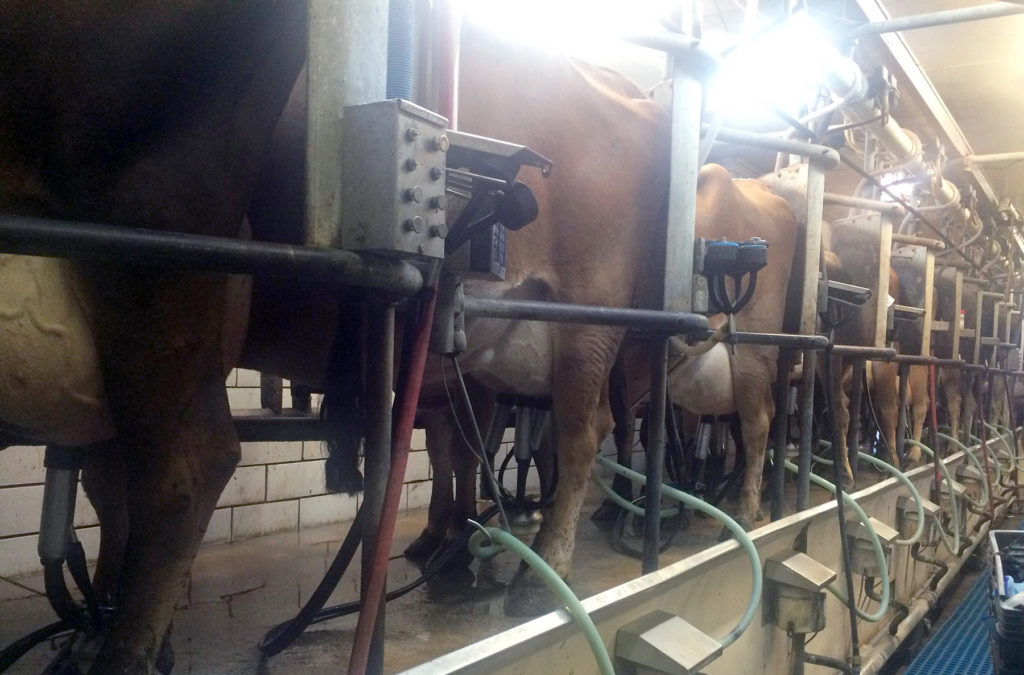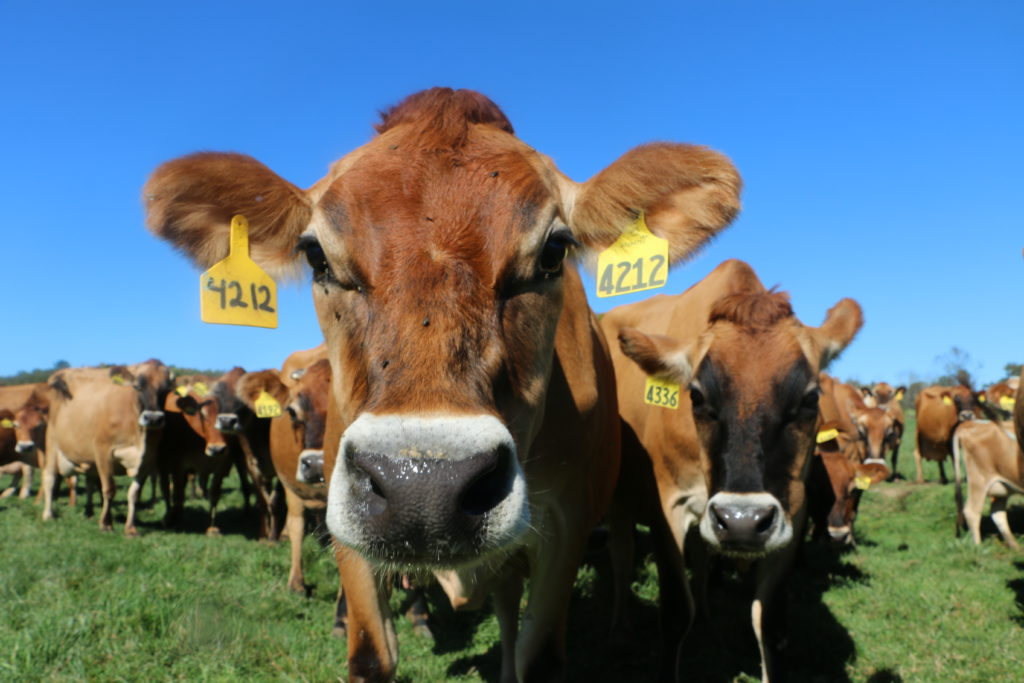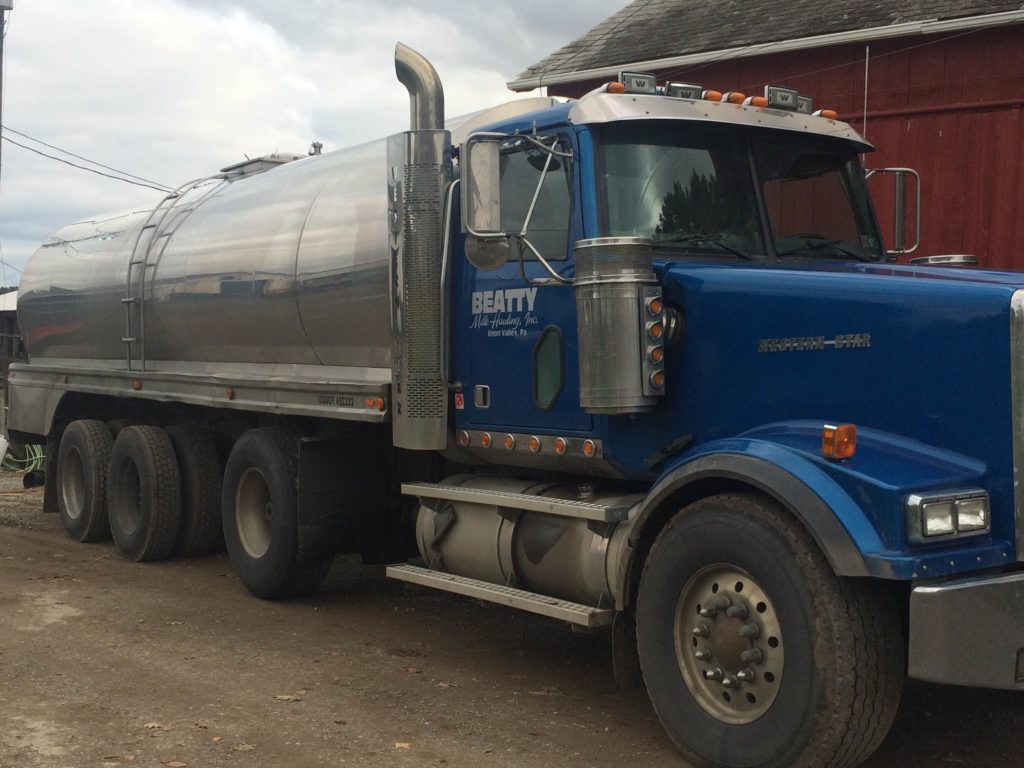Dairy farming has come a long way from what it used to be. From cow feed to antibiotic use, I’m sharing a glimpse into the life of a dairy farmer, so you can see where your dairy comes from.
{Disclosure: I created this blog content in partnership with the American Dairy Association North-East. I was compensated for my work, but all opinions are solely my own. For additional information and resources on dairy farming, visit the their website.}
June is Dairy Month! Do you know where your dairy foods come from?
Some of you might visualize the old-school farm that you grew up next as a kid. Others might picture the grocery store where you buy your food. Whatever your thoughts about today’s farming practices might be, I’m here to bring you up-to-speed on modern dairy farming.
Agricultural Systems Management Is An Important Field Of Study
Over my years as a dietitian, I have been on many farm tours. I admittedly hate the smell of manure, but I learn much more from a real experience than hearing it from someone else. And I’m definitely an “I’ll believe it when I see it” type of person. I prefer to be shown, not told. And, I definitely need evidence before I start spreading nutrition news. That brings to me to this post!
My knowledge on dairy farming didn’t come from my childhood– I didn’t grow up on a farm and my exposure to farm animals was limited to the petting zoo at the county fair. I didn’t have much exposure to farming until college- and even that was limited. Penn State University, where I obtained my undergraduate degree, is a huge agriculture school. I still remember the day I learned that people actually study agriculture as a college major. I had no idea people, my peers, could or would choose to study agriculture systems to learn ways to improve and modernize farming. Up to that point, I spent very little time thinking about how food was grown, much less, who was growing it. I had a lot to learn.
Modern Farming Looks Way Different Than Years Ago
While I’m undeniably a city girl, I love visiting farms and I love talking to farmers. And so, the farms tours began. I didn’t stop at visiting one farm, or two or three. I’ve visited more farms than I can count and interviewed numerous farmers– always comparing notes on the different farming systems and listening to the various reasons farmers give for choosing the system they have in place. It really is fascinating to see the food that feeds the world being grown, prepared and shipped to our super markets. The technology has come such a long way from years ago, resulting in greater production with less physical labor. And, thank goodness- modern farming makes it possible to produce enough high-quality food to feed the population, especially in years to come.
Though farming systems differ– from large conventional farms to small organic farms– I’ve found one thing to be very consistent among farmers. Farmers love their animals. Every time I leave a farm I think, “I wish that every person who relies on another person- a farmer– to grow their food, understood a day in their life.” A lot of work goes into putting food on your plate.
To help you appreciate what it truly takes, I’m taking you on a virtual trip. We’re headed to a small town in western Pennsylvania known as Enon Valley to visit Kenny Jersey Farm, a family-owned dairy farm. Now let’s go……

A Day In The Life Of A Dairy Farmer
Imagine pulling up to the farm, early in the morning, as the sunrises over the farm. Most of the world is sound asleep, but for a farmer, it’s time to get busy. Over 200 Jersey cows sit on this farm waiting for their caregiver– they want milked.
Meet The Farmers
When we arrive, we are greeted by Clayton and Renee Kenny. Clayton and Renee were both born and raised on a dairy farm. They were childhood friends, then after Renee finished college and Clayton was home on his family’s farm, they reconnected and got married. Interestingly, Renee graduated from my alma mater, Penn State, where she studied animal science. In 2012, Claytons father passed away. That’s when they took over ownership of the Kenny Jersey Farm- the same farm that Clayton grew up on.

Renee describes the farm as being very similar today, as it was years ago. Both Clayton and Renee manage and work on the farm. Renee also works part-time to supplement the family income and as a creative outlet for her own passion of the dairy industry. If you’re looking for some yummy recipes using dairy, make sure you check out her blog EatFarmLove. And, follow her social posts on Facebook and Instagram. Now that you have a bit of background on the farm and family that own it, let’s dive into the day in the life of a farmer. Specifically, Clayton and Renee.
Modern Day Farming Milking Practices
It’s 6:00 am. That means, it’s time to milk the cows. Morning milkers head to the milking parlor to get started. In addition to Clayton and Renee, two other full-time employees and some part-time help, work on the farm. Their cows are milked using a parlor system. The system that the Kenny’s use allows twenty (20) cows to be milked at a time. Renee shares that it takes ~3-4 hours to milk all of the cows, and they milk two times a day.

At the same time that the cows are being milked, Clayton heads over to the calf hutches to get them fed. The calves are fed a milk replacer from a bottle. As they mature, they are fed grain and water, too and eventually hay.

What Do Cow’s Eat?
My next line of questioning was about the feed. As with other farms, Renee explained how they work with a feed company to determine and supply the ration. A nutritionist from the feed company comes to the farm every other week- takes samples of the feed, weights the animals, looks at the health of the cows, etc. From that, a ration of nutrients is created to feed the cows.
A ration is similar to a recipe– it is a mixture of minerals, soybean meal, vitamins, corn, hay, etc. that the cows will be fed. Not all farms need the same ingredients from the feed company. For example, the Kenny’s raise soybeans on their farm. If they chose, they could make their own soybean meal as part of the ration. But, Renee explained that they choose to get the soybean meal from the feed company because it would cost too much for them to roast and grind it themselves.
Learn more about the feed rations here.
I wondered how often the ration changes. When asked, Renee said that it’s always changing. Especially in the summer months when the cows spend more time eating fresh grass in the pasture. Having fresh grass available means they don’t need as much hay. That’s a win for a farmer, since it helps to lower the feed bill.
I also asked about cow behavior. I wondered if they notice a difference in how cow’s act when they spend more time grazing. “Not really, Renee said. “Jersey cows are curious and have big personalities, and they enjoy being in the pasture or in the barn.” “The amount of time they spend in the pasture depends on weather, as well as a management style. Look at that face- adorable!

Other Work On The Farm
The work continues on the farm. Mixing and preparing feed takes a big chunk of the day; most days, 3-4 hours is spent on this task. Each cow on the Kenny farm consumes ~50# of feed per day, which is fed over three batches. While responsibilities such as milking and preparing the feed need done daily, other tasks are much less predictable. Some days’ time is spent fixing equipment, finding and purchasing equipment parts or working with the veterinarian.
Next is managing the field crops. This day, the corn and soybeans need planted, so off to the tractor Clayton goes. The next few hours he’ll be getting on and off the tractor, filling the seed and fertilizing the field. Last week, they harvested hay and made roundbales and haylage.

It’s been a busy day on the farm thus far, but it’s not over. Once the planting is complete, Clayton takes a quick break then heads back to the milking parlor. It’s time for the cow’s to be milked for the second time today. Once this feeding is done, he can relax with the rest of the family.
That is a typical schedule in the spring, summer and fall, when crops are being cared for along with the cows. The winter welcomes some time off from the tractor and allows them to get the equipment ready for the next year.
The Safety Of Our Milk Supply
The day is winding down, but I have a few more questions for Renee and Clayton. The safety of our milk supply is a big concern for consumers, so I wanted to discuss a few milk myths. One common concern in dairy farming is the use of antibiotics. Despite what you might have read on the internet, farmers do not pump cows with antibiotics to keep them healthy. They do, however, use them to treat illness – similar to the way a parent would give antibiotics to a sick child. While that might sound concerning, it’s not! Safety precautions are taken to make sure that any antibiotics used to treat a sick cow do not get into the milk supply for human consumption. I asked Renee to share how she knows when one of their cows are sick. She explained it as follows:
“Farmers are in their barns multiple times a day. Like a mom with her child, you can just tell when one of the cows is not feeling well. It might be that she is laying down when she would normally be up moving around. Cold ears or a decrease in milk production are other signs. Our milking units are able to tell us how much milk is produced in a day. If that is low, that could be an indicator that something is wrong. A change in behavior is the most common indicator.”
Renee further explained how they handle a sick cow. She described Mastitis– an infection in the mammary system– as one common infection that might require antibiotics.
“If a cow is sick, she might require antibiotics to treat the infection,”she says. “In that case, she would be moved to a separate hospital pen specifically for animals that require extra attention. They get milked after all of the other cows, and that milk gets dumped and never reaches our milk tank.”
Not everyone realizes it, but milk is tested multiple times before it makes it to the shelf or goes into products. The Kenny’s sell their milk to United Dairy. When the milk hauler gets to the farm to collect the milk, it is first tested for antibiotics, hormones, contaminants, etc. directly from the milk tank at the farm. It is transferred to the dairy tank on the truck to be transported to the dairy company. In the case of the Kenny’s, it’s headed to United Dairy in West Virginia. Once the milk gets to United, it is retested before it is packaged as fluid milk or used to make other dairy products. According to Renee, the time from pick up to grocery shelf can occur in as little as 48-hour period.

My last request of Renee was to share something she wishes people knew about dairy farming and farmers. Her response was as follows:
“I wish people who don’t have first-hand knowledge of dairy farming wouldn’t automatically believe the negativity that they read on the internet. I think people forget that dairy farmers are people, too. Clayton and I have two young children who drink the milk that we produce. If it was harmful, we certainly wouldn’t be feeding it to our family. But this is our business, too. Our kids go to a daycare somedays because the work has to get done. We chose this as our business because we love this lifestyle, the cows and the farm.”
I have to agree with Renee. Nothing makes me appreciate dairy farming more than seeing a farmer in action. As Renee put it, “We don’t ever have the same day- some days are busy, some days are busier and some days are busiest!”
No doubt, dairy farming is hard work Have you thanked a farmer lately for growing your food? If not, maybe it’s time.
If you’re looking for more inforamtion on the nutrition found in dairy, or want to read about dairy alternatives, check out my post on the difference’s between cow’s milk and plant-based milk alternatives.
Special thank you to Renee Kenny for allowing me into the life of her family, farm and photos. All photos curtesy of Renee and Clayton Kenny.


 Hi, I’m Heather – a registered dietitian, busy mom, consultant, adventure junkie and travel addict who has mastered living healthy on the go. My blog is where I share simple recipes and healthy living tips to help and inspire others to live their best life.
Hi, I’m Heather – a registered dietitian, busy mom, consultant, adventure junkie and travel addict who has mastered living healthy on the go. My blog is where I share simple recipes and healthy living tips to help and inspire others to live their best life.